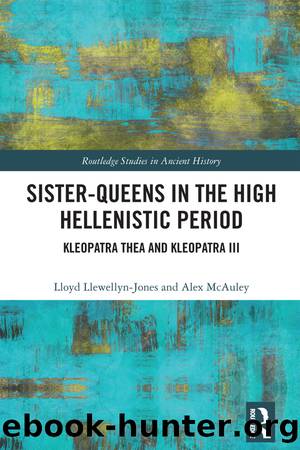Sister-Queens in the High Hellenistic Period by Lloyd Llewellyn-Jones;Alex McAuley; & Alex McAuley

Author:Lloyd Llewellyn-Jones;Alex McAuley; & Alex McAuley
Language: eng
Format: epub
Publisher: Taylor & Francis (Unlimited)
Published: 2023-01-15T00:00:00+00:00
Meanwhile in Alexandriaâ¦
In Egypt, Ptolemy VIII was behaving very much like an old-school polygamous Hellenistic king, flaunting, it would seem, his harem of two wives. Justin and Valerius Maximus insist that Ptolemy repudiated Kleopatra II when his second wife gave birth to her son, but this is not supported by the Egyptian evidence, although it must be conceded that demotic documents of the late 140s BCE do display confusions in the titles and relationships of the king and his wives. A âkaleidoscopic arrayâ of approaches to the royal familyâs oddities emerge.74 On 8th May 141 BCE, for instance, a Theban document tells of pharaoh Ptolemy and âqueen Kleopatra and Kleopatra the Beneficentâ alongside eponymous priestesses for the cult of the two queens who hold the tiles âthe priestess of queen Kleopatraâ and âthe priestess of Kleopatra the Daughter of the Kingâ.75 Another demotic text of September 140 BCE declares Ptolemy VIII to be ruling alongside âKleopatra, his sister, his wife, the goddess, the Beneficent Oneâ and that cult is still performed by priestesses of âqueen Kleopatraâ and âKleopatra, the Kingâs Daughterâ. This suggests that Kleopatra III was not yet being recognised everywhere as queen, although a Greek papyrus of July 141 (or 140) BCE lists the same priestesses as âthe priestess of queen Kleopatra and of queen Kleopatra the daughterâ, inferring an increase in status for the younger wife.76 The kingâs new wife was not a woman to be easily ignored. She had shown that when still a princess, but as queen she was determined never to be kept in the shadows.
During the formative era of the tripartite marriage, Kleopatra III developed from a wilful ingénue into strong woman. The sophisticated power games of her husband and her mother must have provided Kleopatra with a model for rulership, giving her a blue print of successful strategies and a dossier of ignominious failures. Volkman is probably right when he speculated that âmother and daughter fought against each other with a hatred that was irreconcilableâ,77 although throughout these turbulent years, Kleopatra III nonetheless benefitted from watching her motherâs methods of rule, for in spite of all that had passed, Kleopatra II was still able to maintain precedence over her daughter, a fact well attested in the prescripts and inscriptions of the time. Whether the elder queenâs success was due simply to her own charisma or to the powerful supporters she maintained both within Egypt and beyond its borders, or a combination of the two, is hard to say, but that she maintained her preeminent position is clear and the tenacity by which she clung to power must have provided inspiration for her angry daughter who, when her turn came, was to maintain an unflinching precedence over both of her sons once they had ascended the throne.
At the end of 140 BCE the royal triculture finally settled down into a regular pattern which would continue until 132 BCE. A Greek royal circular provides us with its earliest attestation: âKing Ptolemy and Queen Kleopatra the Sister, and Queen Kleopatra the Wifeâ.
Download
This site does not store any files on its server. We only index and link to content provided by other sites. Please contact the content providers to delete copyright contents if any and email us, we'll remove relevant links or contents immediately.
| Africa | Americas |
| Arctic & Antarctica | Asia |
| Australia & Oceania | Europe |
| Middle East | Russia |
| United States | World |
| Ancient Civilizations | Military |
| Historical Study & Educational Resources |
A Woman in Arabia: The Writings of the Queen of the Desert (Penguin Classics) by Gertrude Bell(1051)
The Lady Penelope by Varlow Sally(970)
The Book of Gutsy Women by Hillary Rodham Clinton(800)
The Vindications by Mary Wollstonecraft(763)
The Indifferent Stars Above: The Harrowing Saga of a Donner Party Bride by Daniel James Brown(755)
Looking for Miss America by Margot Mifflin(748)
Outlaw Marriages by Rodger Streitmatter(722)
Lives of Roman Christian Women by Carolinne White(709)
The Makers of Rome (Penguin Classics) by Plutarch(690)
Jane Austen: A Life by Claire Tomalin(690)
Cleopatra the Great by Joann Fletcher(684)
The Targeter by Nada Bakos(684)
Cunt by Inga Muscio Betty Dodson(665)
The Women With Silver Wings by Katherine Sharp Landdeck(648)
Difficult Women by Helen Lewis(646)
Crossing the Plains with Bruno by Annick Smith(636)
Love by Unknown(622)
Rejected Princesses: Tales of History's Boldest Heroines, Hellions, and Heretics by Jason Porath(616)
The Age of Alexander (Penguin Classics) by Plutarch(612)
